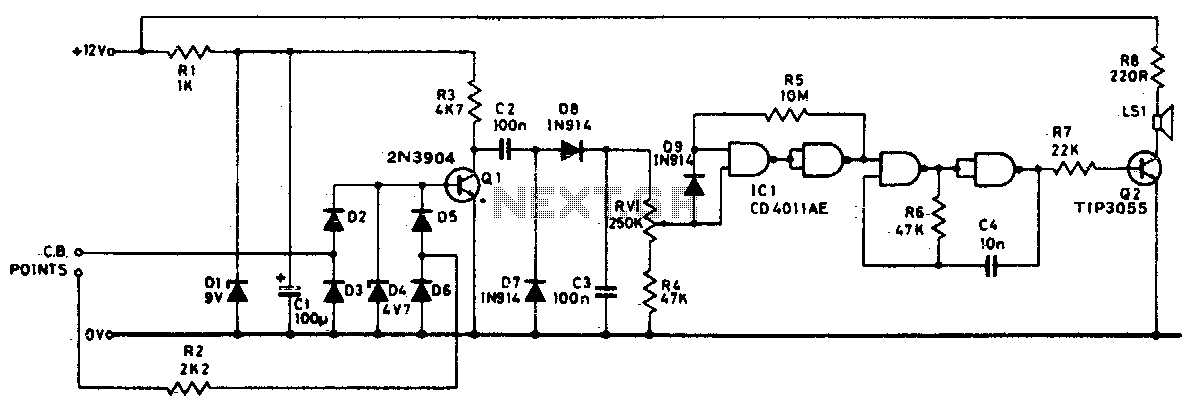
Simple Light Sensor Alarm circuit with NE555

This circuit triggers an alarm when its LDR (Light Dependent Resistor) sensor is exposed to light from the sun or a lamp. A 555 astable multivibrator is utilized to generate a tone of approximately 1 kHz upon detecting light. When the sensor is illuminated, it completes the circuit, causing the 555 timer to oscillate at around 1 kHz, with a transistor used to drive the current. The sensitivity can be adjusted with a potentiometer (P1). This configuration allows sunlight to flow through to the ground, preventing the alarm from activating due to residual light on the sensor.
The circuit employs a 555 timer configured in an astable mode, which is ideal for generating a continuous square wave output. The LDR serves as a light-sensitive resistor whose resistance decreases significantly when exposed to light, thus allowing current to flow through the circuit. The output frequency of the 555 timer is determined by the resistor and capacitor values connected to it, with the frequency approximately set at 1 kHz in this application.
In this design, the LDR is connected in series with a resistor to form a voltage divider. When light falls on the LDR, its resistance drops, resulting in a higher voltage at the input of the 555 timer, triggering it to oscillate. The output from the 555 timer is fed into a transistor, which acts as a switch to control a larger load, such as a buzzer or alarm system.
The sensitivity adjustment feature, implemented through potentiometer P1, allows for fine-tuning of the light threshold at which the alarm activates. By varying the resistance, the circuit can be made more or less responsive to changes in light levels, providing flexibility in different lighting conditions.
Overall, this circuit is a practical solution for creating a light-activated alarm system, suitable for various applications such as security systems or alert mechanisms in environments where light levels need monitoring. The simplicity of the 555 timer circuit combined with the LDR sensor provides an effective and cost-efficient method for detecting light and activating an alarm.This circuit sent out an alarm when its LDR sensor is exposed to light by sun or lamp. A 555 astable multivibrator was used here which sent signal a tone of about 1kHz upon detecting light. The sensor when exposed by light completes the circuit and makes the 555 oscillate at about 1kHz with transistor to drive current.
Sensitivity can be adjust wit h P1. This makes the sun light to flow through it to the ground and prevents the alarm from going on due to the stored light on the sensor. 🔗 External reference
The circuit employs a 555 timer configured in an astable mode, which is ideal for generating a continuous square wave output. The LDR serves as a light-sensitive resistor whose resistance decreases significantly when exposed to light, thus allowing current to flow through the circuit. The output frequency of the 555 timer is determined by the resistor and capacitor values connected to it, with the frequency approximately set at 1 kHz in this application.
In this design, the LDR is connected in series with a resistor to form a voltage divider. When light falls on the LDR, its resistance drops, resulting in a higher voltage at the input of the 555 timer, triggering it to oscillate. The output from the 555 timer is fed into a transistor, which acts as a switch to control a larger load, such as a buzzer or alarm system.
The sensitivity adjustment feature, implemented through potentiometer P1, allows for fine-tuning of the light threshold at which the alarm activates. By varying the resistance, the circuit can be made more or less responsive to changes in light levels, providing flexibility in different lighting conditions.
Overall, this circuit is a practical solution for creating a light-activated alarm system, suitable for various applications such as security systems or alert mechanisms in environments where light levels need monitoring. The simplicity of the 555 timer circuit combined with the LDR sensor provides an effective and cost-efficient method for detecting light and activating an alarm.This circuit sent out an alarm when its LDR sensor is exposed to light by sun or lamp. A 555 astable multivibrator was used here which sent signal a tone of about 1kHz upon detecting light. The sensor when exposed by light completes the circuit and makes the 555 oscillate at about 1kHz with transistor to drive current.
Sensitivity can be adjust wit h P1. This makes the sun light to flow through it to the ground and prevents the alarm from going on due to the stored light on the sensor. 🔗 External reference





